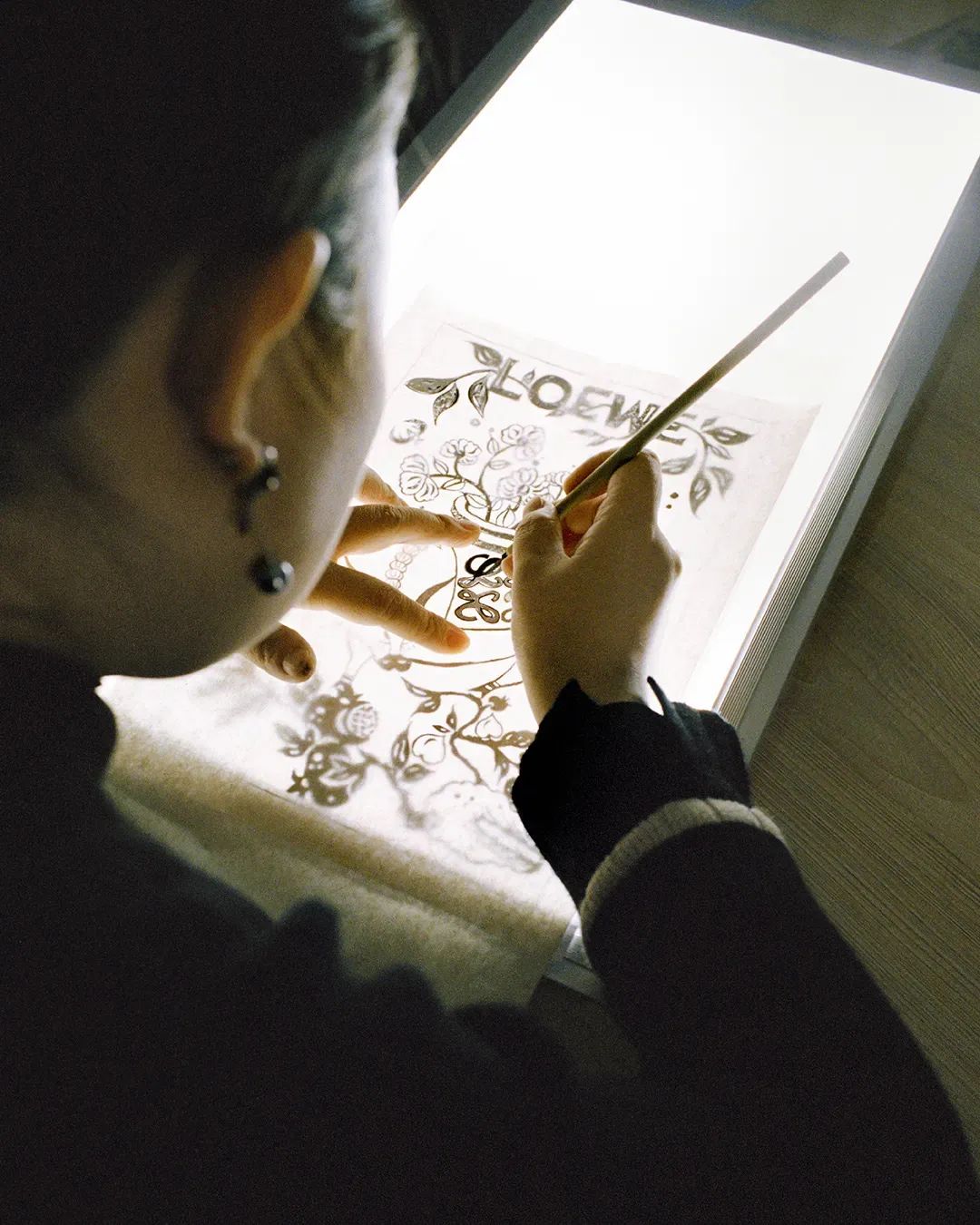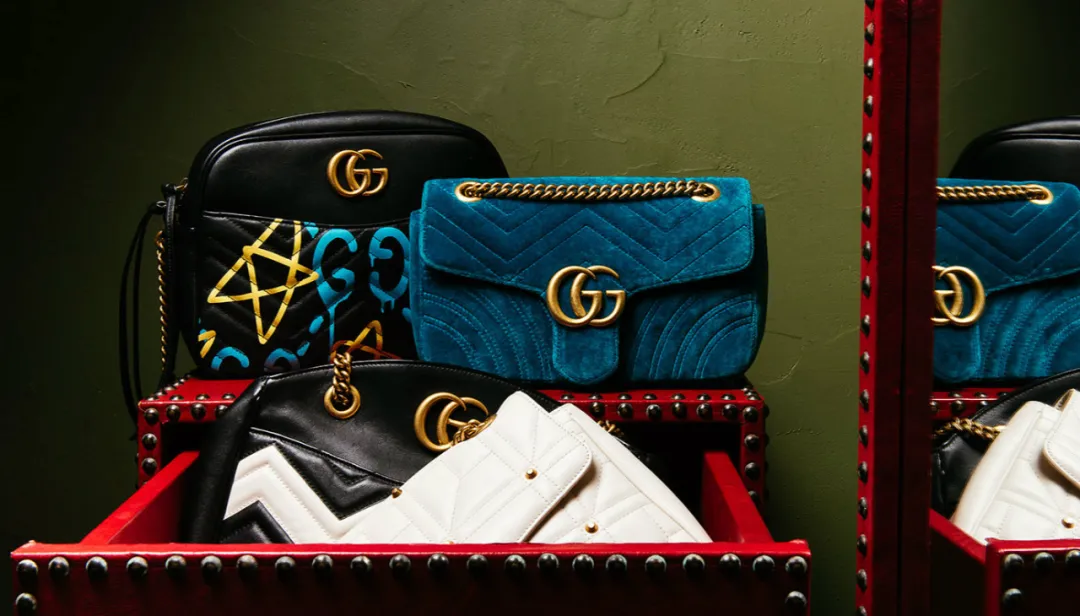The cultural marketing competition of luxury brands in the Chinese market has no ceiling.
According to Fashion Business News, LVMH’s Spanish luxury brand Loewe recently launched the 2023 early spring collection inspired by Chinese monochrome glaze. Ten traditional Chinese colors, including light blue, white, and blush, were selected from the clear glaze colors and integrated into the brand’s clothing and iconic bags, such as Puzzle, Hammock, Flamenco, with the aim of paying tribute to the minimalist ceramic aesthetics of the Ming and Qing dynasties.
This Chinese culture series has received almost overwhelming praise on social media. Some netizens have bluntly stated that Loewe can be regarded as one of the most successful local marketing cases for luxury brands in China.
As of now, the official Xiaohongshu account of Loewe has received over 5500 likes for its monochrome glaze series copywriting, and over 2500 likes for its first video notes, which is ten or even a hundred times more than the brand’s previous posts.
Despite the increasing frequency of communication between luxury brands and Chinese culture, there are not many luxury Chinese cultural marketing projects that have sparked heated discussions on social media while receiving positive reviews from different circles. Especially for Loewe, who has been relatively low-key in recent years, being able to return to the center of public opinion with the reputation of the monochrome glaze series once again proves that a good idea is always more effective than throwing a huge marketing budget.
Especially during the period of frequent controversies related to cultural appropriation, exploring what Loewe has done correctly is very instructive for luxury brands that are currently in some confusion in the Chinese market.
Firstly, compared with colored porcelain such as blue and white porcelain, monochromatic glaze is not a very familiar category for many contemporary Chinese consumers. However, it unexpectedly received “reverse popularization” from Western luxury brands, whose deep understanding of traditional Chinese culture left a good first impression on the audience.
Secondly, it is not easy to actively explore and deeply understand traditional Chinese culture. It requires ingenious thinking to integrate these obscure and difficult to spread elements into contemporary design, so that Chinese and even global consumers can understand and ultimately transform them into purchasing impulses.
Compared to concrete elements in Chinese culture such as dragons, phoenixes, and auspicious clouds, Loewe extracts the simplest and most intuitive design language, which is color.
Throughout the entire series album, Loewe only uses black and white gradient colors as the background, placing a gourd bottle side by side with a bag of the same color, allowing consumers to immediately understand the inspiration for the series without any language.
Due to different cultural backgrounds and environments, each ethnic group has a different understanding of color. In traditional Chinese painting, sculpture, and other arts, the Chinese traditional color of “taking the true color of all things” is a unique aesthetic language that integrates concepts such as nature, ethics, philosophy, and the universe. It is a cultural asset worth cherishing in China.
Many Western creations consider red and bright yellow as representatives of Chinese tradition, but this understanding is extremely one-sided. For many Chinese consumers who value the beauty of subtlety and blank space, incorporating Chinese red into their designs to reflect the imprint of Chinese culture is rigid and clich é d.
In the book “Chinese Traditional Colors: The Aesthetics of Colors in the Palace Museum” jointly published by the National Palace Museum of China and color experts, scholars have sorted out 384 Chinese traditional colors from over 400 literature and classics related to colors, and selected 96 corresponding cultural relics to display in the book. Among them, there are monochromatic glazes that are praised for their elegance and simplicity.
Although monochromatic glaze has a single color, it is completely derived from nature, which makes Loewe’s color marketing different from dazzling luxury brand color marketing such as BV green and Valentino fluorescent powder. It also brings soothing emotional value to visually stimulated audiences who are oversaturated.
It is worth pondering that from an economic perspective, Loewe has hardly leveraged such achievements at a high cost.
In fact, these handbags may not be particularly noticeable after removing the contrast of porcelain, and the colors of the handbags are completely in line with Loewe’s consistent creative spectrum. The concept of monochromatic glaze brings a single color to handbags, making it less likely for creative teams to make mistakes and avoiding the disharmonious color matching caused by the Chinese special series of “proposition essays”, which in turn affects the practicality of handbags.
Chinese color terms such as “light eggplant skin purple”, “glaze white”, “lang hong”, and “tea powder” have given new concepts to the colors that Loewe is already using and can be seen on a daily basis. This kind of cooperation is more like a reproduction of ideas, after all, the crowded co branded market does not require more new things.
There is no need to design a new model vigorously, Loewe cleverly creates a sense of freshness by changing the context of the product. This further reflects Loewe’s thinking on contemporary design, which is no longer about new designs, but about resetting the classic context.
In addition to considering the product itself, this series also provides a more sustainable reference for the industry in the allocation of marketing budgets.
Compared to homogeneous promotions such as inviting celebrity platforms and large-scale placements on social media, brands have invested more budget into hosting exhibitions, producing short films, and making public donations, while further deepening the cultural value of the series.
To pay tribute to the monochrome glazed ceramic handicrafts, Loewe held the “China Monochrome Glazed Ceramic Exhibition” at the 10th ART021 Shanghai 21 Contemporary Art Expo from November 10th to November 13th, showcasing the monochrome glazed ceramic golden bell bowl series art works created by Deng Xiping, a representative inheritor of national intangible cultural heritage. After the exhibition, these 160 works will be sent to Loewe stores to have closer contact with consumers across the country.
In addition, Loewe specifically visited Jingdezhen to record the porcelain making process of monochromatic glazed ceramic artist Lei Zi in the form of short films. In just three minutes of video, the language of the camera is natural and plain, without any flashy skills, showcasing the fusion of culture and nature.
In recent years, deep tourism has emerged in China, and some once niche cultural and tourism destinations have gradually attracted people’s attention. Jingdezhen, known as the “porcelain capital,” is one of them. Many young tourists come to admire the unique mountain and forest scenery and the long history of ceramic culture, and publish a large number of travel notes on social media. This natural tourism trend also serves as natural traffic, promoting the efficient dissemination of this marketing.
It is worth mentioning that, taking this series as an opportunity, Loewe will donate funds to support Jingdezhen Ceramic University, the only multidisciplinary university in China with a focus on ceramic research, and launch a new “monochromatic glazed ceramic education project” here, allowing more young students and artists to continue to inherit this craft, once again demonstrating their full sincerity towards traditional Chinese culture.
Overall, the Loewe China Monochrome Glaze series has achieved a good balance from product concept to marketing promotion. This balance is between cultural and commercial aspects, the brand’s own philosophy and cultural exchange objects, the brand’s internal development, and external market hotspots.
As domestic consumers gradually mature, the market’s expectations for the sincerity of luxury brands are also constantly increasing. Especially at the level of local culture, the recent controversial issue of cultural appropriation has made consumers more sensitive to such marketing. It is not a day or two before those serious homogenization and superficial Spring Festival series or Qixi marketing have been criticized.
In fact, behind these controversies is often an imbalance in the internal logic of the brand. Sometimes, luxury brands fall into the trap of excessive flattery in order to cater to the Chinese market, ignoring the uniqueness and methodology of the brand itself.
For many consumers, Loewe China’s monochrome glaze series may be a one-time successful cultural marketing. But consumers who have a deeper understanding of the brand will realize that this is just one of Loewe’s stops on the long-term exploration of the craftsmanship path.
Jonathan Anderson, the creative director of celebrities, gradually developed a deep interest in the arts and crafts of his competitors after taking over Loewe. For example, William Morris met the punk capsule series in 2017, the capsule series launched in 2018 to pay tribute to Scottish architect Charles Rennie Mackintosh, and the special capsule series inspired by English ceramic artist and arts and crafts movement representative William De Morgan in 2019.
Jonathan Anderson also founded the Loewe Foundation Craft Award in 2016, which is the world’s first international contemporary craft award. Jonathan Anderson admits, “In a sense, I see myself as a curator.” He is not a traditional fashion designer who excels in making “clothes,” but rather extends his reach to different fields, constantly collaborating with artists and creative talents.
Just as Alessandro Michele established a complete world for Gucci, Jonathan Anderson actually gradually established a complete cultural system for Loewe. The Casa Loewe Loewe House, opened in Sanlitun, Beijing in 2019, indirectly proves that Loewe has reached a certain level of completeness, allowing people to feel a space filled with Loewe style aesthetics, values, and lifestyle. In addition to the brand’s own products, the space also displays multiple installation art works from around the world.
Since 2019, Loewe has launched a series of advertising videos during the Lunar New Year to document China’s traditional craftsmanship and craftsmanship spirit. In 2021, Loewe collaborated with the magazine Wallpaper to visit three traditional Chinese craft families and document the stories of inheriting ancient Chinese craftsmanship through family ties – Fengxiang Wooden New Year Painting, Huizhou Fishing Pavilion Cake, and Daoming Bamboo Weaving. This year, Loewe invited young actor Wu Lei and professional chef Zhu Liming to jointly present a Chinese New Year movie with the theme of exploring the mysteries of making dumplings.
In the eyes of many consumers, it seems that Loewe has not created too many topics on social media in the past few years, and the brand has also been slightly marginalized due to the lack of new popular products. However, from the continuous investment in handicrafts and culture mentioned above, the short-term business dilemma has never stopped brands from adhering to cultural construction.
In previous comments on the WeChat official account LADYMAX, it was pointed out that Loewe did not waste crisis even in the epidemic. For a long time since large-scale fashion shows could not be held, Loewe has explored new entity release innovative concepts, presenting creativity with rich materials such as “show in box”, “show on wall”, “show in book”, “show on clothes” and “show in newspaper”.
It can be seen that Jonathan Anderson developed a methodology for Loewe to replace fashion shows in just one year. The core of this methodology is to focus on substance and emotion, seeking connections with the audience, rather than just entertaining them with glamour and false luxury.
The innovation of fashion shows during the pandemic alone has demonstrated Jonathan Anderson’s excellent systematic summarization ability. Expanding to the overall brand, craftsmanship is the “method” he created for Loewe.
It is not difficult to understand that the original intention of Loewe’s connection with Chinese monochrome glaze is not to show goodwill towards Chinese culture. But starting from exploring global handicrafts, and then focusing on China’s unique cultural assets. Interestingly, when brands no longer try to please Chinese culture, their sincere attitude becomes apparent.
There is a growing consensus in the current market that Chinese consumers need equal dialogue. They expect brands to respect true Chinese traditions, but they also do not want brands to excessively cater and lose their composure.
Advanced, lively, profound, and popular, the core of Loewe’s successful marketing lies in the fact that the brand did not deliberately add Chinese cultural symbols, but found commonalities in concepts, connecting the creative lineage of Chinese culture and Loewe brand itself.
Of course, in the increasingly noisy market environment, brands that always adhere to their unique concepts may not always receive widespread attention from social media, and cannot escape the fate of being mediocre. Texture and reputation may not always be translated into sales figures.
It is not easy to achieve a win-win situation of reputation and sales in the Chinese market, and many people even assume that the two cannot be achieved simultaneously, and that brand depth must be abandoned for short-term benefits. However, Loewe’s example proves that sustainable deep connections do not necessarily lead to being ignored. Perhaps the brand is at a disadvantage in the short-term market attention competition, but in the long run, it has accumulated strong and competitive brand assets.
With Jonathan Anderson’s recent return to a passionate creative state in Loewe and personal branding, Loewe’s continued leap in business is almost predictable. This all-around celebrity creative director, who has reshaped the luxury goods industry with the Loewe brand and initiated a brand rejuvenation trend in the past decade, has a more comprehensive and comprehensive control over the brand. He knows how to leverage the brand’s potential in the most clever way, and how to low-key without deliberately driving the brand’s pace in the Chinese market with a successful Chinese cultural series.
At present, many Chinese consumers have accepted sincere dialogue and deep luxury brands, but it is precisely the brands that are not yet ready. When luxury brands fill every traditional Chinese festival with a large amount of marketing resources, strategic laziness is becoming increasingly difficult to conceal.
A successful case that doesn’t require any festive background to play by example may truly awaken luxury brands in China that are lost.


















